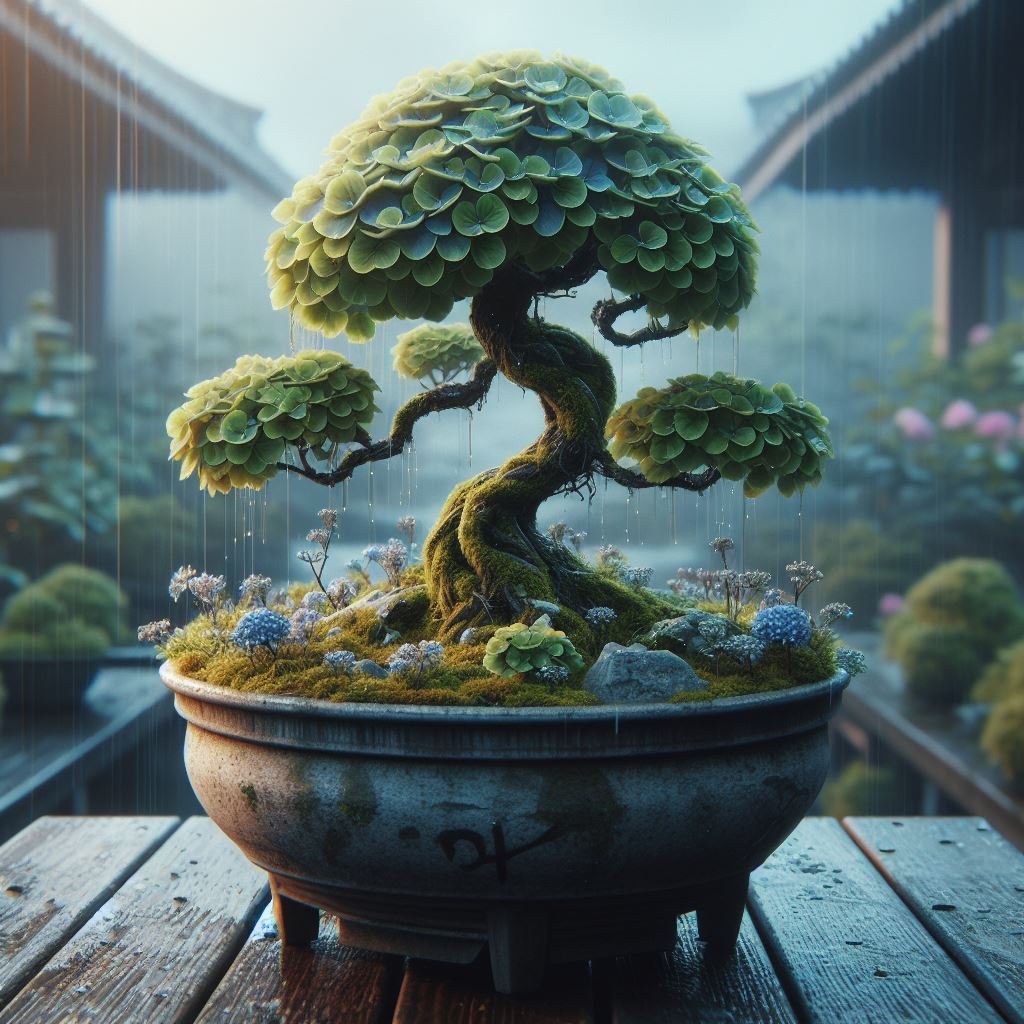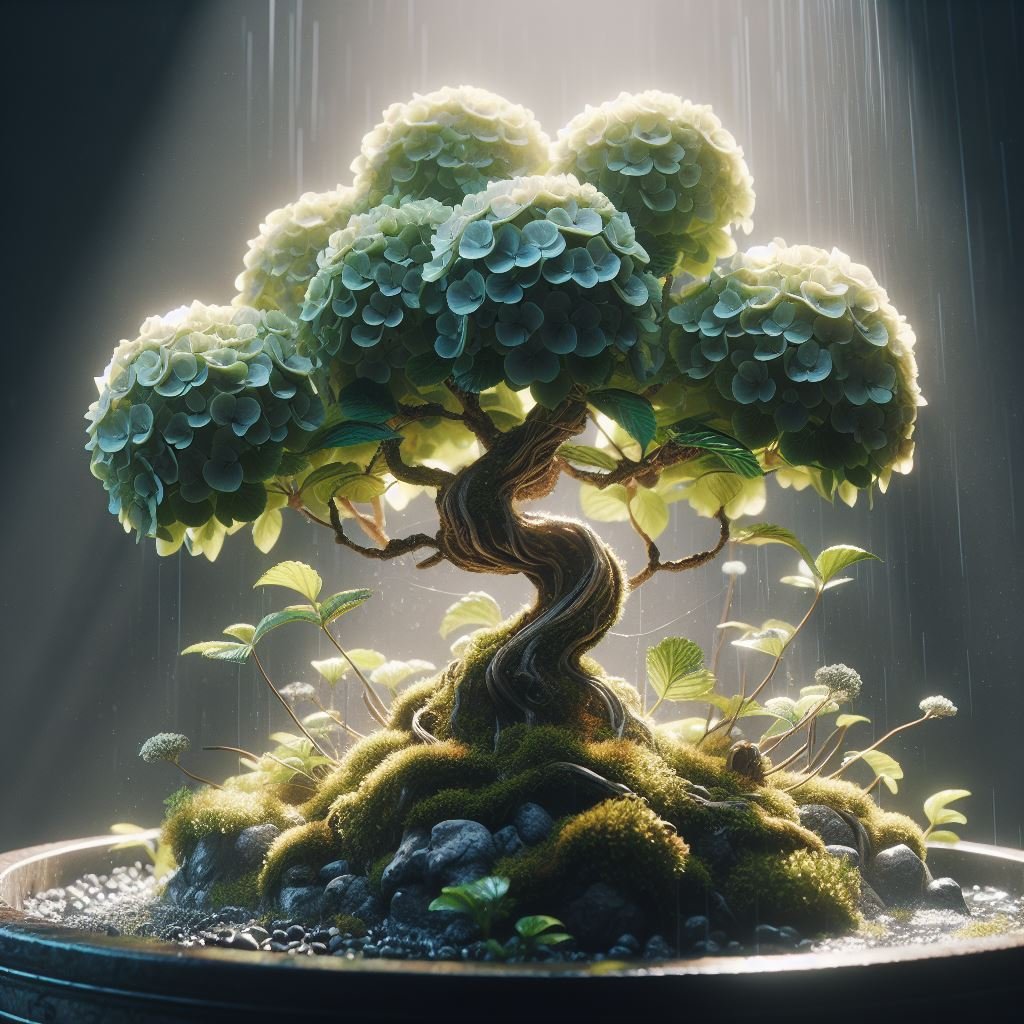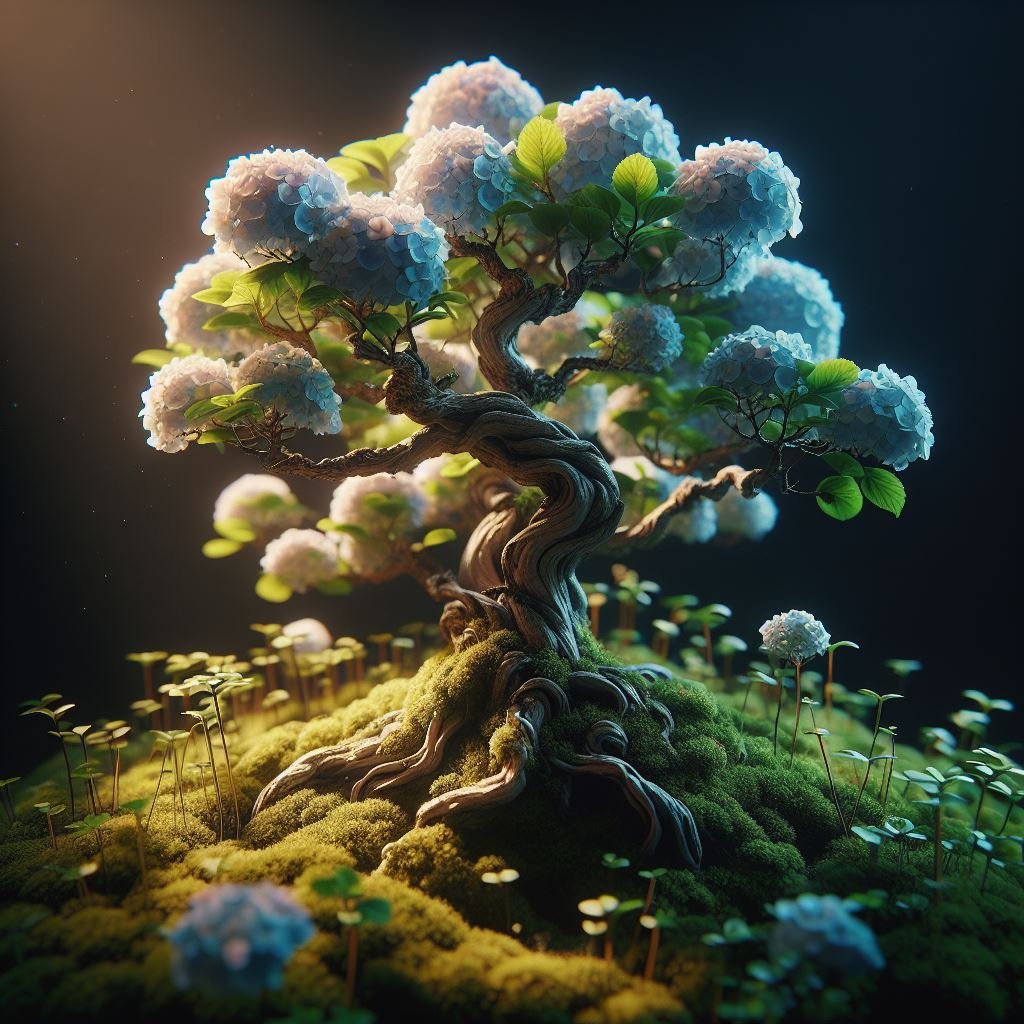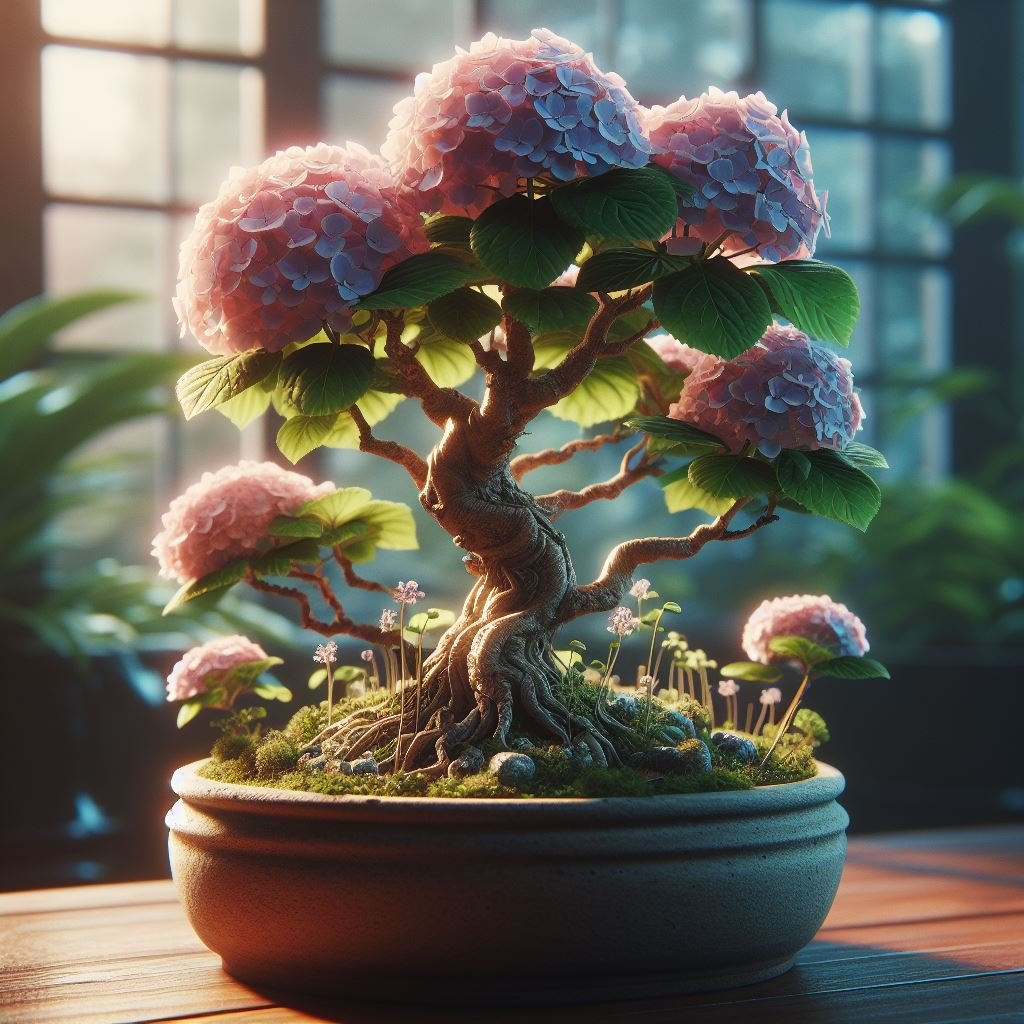Hydrangea Bonsai presents a fascinating blend of nature’s beauty and human ingenuity. These compact trees encapsulate the breathtaking allure of hydrangeas while embodying the aesthetic discipline of bonsai. This article aims to provide an in-depth understanding of hydrangea bonsai, covering its care requirements, pruning techniques, and common challenges, with insights drawn from expert sources and avid growers.
Introduction to Hydrangea Bonsai
The art of bonsai is a harmonious blend of horticulture and aesthetic design that originated in China over a thousand years ago before making its way to Japan, where it was refined and popularized. Among the diverse array of species used for bonsai, one stands out for its exceptional beauty and elegance – the hydrangea.
Hydrangea bonsai refers to the practice of growing hydrangea plants, which are well-known for their large clusters of vibrant flowers, in small containers following the principles of bonsai. The result is a miniature tree that encapsulates the charm of hydrangeas while embodying the discipline and artistic essence of bonsai.

There are several types of hydrangeas suitable for bonsai due to their adaptability and compact growth habit. Some of the popular ones include:
- Hydrangea Macrophylla (Bigleaf Hydrangea): This is the most common type of hydrangea used for bonsai. It’s loved for its large, round flower heads that come in a variety of colors depending on the soil’s acidity.
- Hydrangea Paniculata (Panicled Hydrangea): This type is known for its cone-shaped flower clusters and is more tolerant of pruning, making it an excellent choice for bonsai.
- Hydrangea Quercifolia (Oakleaf Hydrangea): Named for its distinctive, oak-like leaves, this hydrangea has a unique appeal and offers great seasonal interest, with fall foliage adding another dimension to the bonsai display.
By understanding the characteristics and care needs of these hydrangea types, enthusiasts can create stunning hydrangea bonsai that bring a touch of nature’s grandeur into their living spaces.
Caring for Hydrangea Bonsai
Creating and maintaining a hydrangea bonsai requires careful attention to several key factors
Ideal Location and Sunlight Requirements
Hydrangea bonsai prefers a location with morning sun and afternoon shade. They can tolerate full sun, but too much heat can scorch the leaves and cause the flowers to wilt. Indoors, they should be placed near a window that gets plenty of indirect sunlight.
Watering Needs and Humidity Conditions
Hydrangeas need a lot of water, especially during the growing season. The soil should be kept moist but not waterlogged. You should water your hydrangea bonsai when the top inch of soil feels dry to the touch. In terms of humidity, hydrangeas prefer high humidity. If you live in a dry climate, consider placing your bonsai on a tray filled with pebbles and water to increase the humidity around the plant.
Appropriate Soil Type and Container Selection
Hydrangeas prefer slightly acidic soil with good drainage. A soil mix made up of one part peat moss or compost, one part perlite or sand, and one part regular potting soil would work well. For the container, choose a shallow bonsai pot that’s large enough to accommodate the root system of the plant. The pot should have adequate drainage holes to prevent waterlogging.
Pruning and Shaping
The best time to prune a hydrangea bonsai is in late winter or early spring before new growth begins. This helps maintain the shape of the tree and encourages bushier growth. Wiring can be used to shape the branches, but care should be taken as hydrangea branches can be quite brittle.
Fertilizing
During the growing season, hydrangea bonsai should be fertilized every two weeks with a balanced bonsai fertilizer. In the fall and winter, reduce fertilizing to once a month.
Remember, the key to successful bonsai is patience and consistency in care. With time and attention, your hydrangea bonsai can become a beautiful addition to your home or garden.
Pruning and Styling Hydrangea Bonsai
Pruning and styling are key aspects of bonsai care that help maintain the tree’s miniature size and enhance its aesthetic appeal. Here’s how you can apply these techniques to your hydrangea bonsai.

When and How to Prune Hydrangea Bonsai
As per the Rocky Mountain Bonsai Society and the Bonsai Empire Forum, the best time to prune a hydrangea bonsai is in the spring through summer. Pruning helps redirect growth, promotes bushier foliage, and enhances flower production. When pruning, ensure to leave at least three branches on each stem, as suggested by Bonsai Bush. The cuts should be made about 1/4″ above a bud, as recommended by the University of Minnesota Extension.
Tips on Wiring and Shaping:
Wiring is a common technique used in bonsai to shape the branches and trunk. However, hydrangea branches can be brittle, so it’s important to handle them with care. Start by wrapping a thin wire around the branch you want to shape, then gently bend the branch into the desired position. It’s best to wire hydrangeas during their dormant period in late winter or early spring when the branches are more pliable.
Techniques for Creating Different Bonsai Styles with Hydrangeas
The beauty of bonsai lies in its versatility. Depending on your hydrangea’s natural growth habit and your personal preferences, you can create different bonsai styles. For instance, a ‘formal upright’ style could suit a hydrangea with a strong, straight trunk, while a ‘cascade’ style might be ideal for a hydrangea with long, drooping branches. Always remember to work with the tree’s natural form and avoid forcing it into an unnatural shape.
In conclusion, pruning and styling a hydrangea bonsai require a thoughtful approach and a gentle touch. But with practice and patience, you can cultivate a truly unique and beautiful piece of living art.
Overcoming Challenges in Growing Hydrangea Bonsai
While hydrangeas can make beautiful bonsai trees, they are not without their challenges. However, most issues can be overcome with the right knowledge and care.

Common Issues and Solutions:
- Wilting Leaves: If your hydrangea bonsai’s leaves start to wilt, it’s usually a sign of under-watering or over-watering. Ensure the soil is consistently moist but not waterlogged.
- Yellowing Leaves: This could indicate a nutritional deficiency. Hydrangeas prefer slightly acidic soil, so consider using an acid-based fertilizer if you notice yellow leaves.
- Lack of Blooms: If your hydrangea isn’t blooming, it might not be getting enough sunlight. Alternatively, it could be due to over-pruning. Remember to only prune hydrangea bonsai after they’ve flowered to avoid cutting off the next year’s blooms.
- Pests and Diseases: Hydrangeas can be susceptible to pests like aphids and diseases like powdery mildew. Regularly inspect your bonsai for signs of these issues and use appropriate treatments as needed.
Managing Old and Declining Hydrangea Trees:
As hydrangea bonsai age, they may start to decline. Here are some tips on managing this:
- Prune Thoughtfully: Pruning can help rejuvenate an old tree, but it should be done carefully to avoid stressing the plant. Remove dead or diseased wood first, then move on to shaping the tree.
- Report Regularly: Older trees often benefit from being repotted into fresh soil. This can help improve the tree’s health and vigor.
- Provide Proper Care: Even though your tree is older, it still needs regular watering, feeding, and appropriate sunlight to thrive. Don’t neglect these basic care requirements.
- Seek Expert Advice: If you’re struggling with an old or declining hydrangea bonsai, consider seeking advice from a local bonsai club or expert. They may be able to provide specific guidance based on their experience and your particular situation.
Remember, every bonsai tree is unique and may require different care strategies. The key is to observe your tree closely and respond to its needs as they arise.
Showcasing Hydrangea Bonsai
Hydrangea bonsais are a testament to the beauty that can be achieved with patience, care, and intricate gardening skills. Let’s explore some examples of thriving hydrangea bonsais and stories of long-term care and success.

Examples of Thriving Hydrangea Bonsai:
- The “Twist-n-Shout” hydrangea is a variety that can thrive as a bonsai, producing stunning blooms in pink and periwinkle blue (source).
- A unique presentation of hydrangea bonsai can be seen in the mixed color multicolor Hydrangea Macrophylla Seed Bonsai available at Walmart. This variant thrives in full sun and produces a beautiful array of colorful flowers (source).
Stories of Long-Term Care and Success:
- The blog post from bonsaibush.com provides practical steps for caring for a hydrangea bonsai. The author emphasizes that with good soil and proper care, a hydrangea bonsai can thrive and become an attractive addition to any garden.
- An inspiring story about creating a bonsai from a Hydrangea macrophylla can be found on the #PlantHunter YouTube channel. The presenter demonstrates that with patience and dedication, it’s indeed possible to create a bonsai from this hydrangea variety (source).
These examples and stories emphasize that with the right care, hydrangea bonsais can thrive and become a stunning addition to any indoor or outdoor garden.
Conclusion
Growing a hydrangea bonsai can be a rewarding journey, filled with challenges and triumphs. Here’s a recap of the key points we discussed:
- Pruning and Styling: Prune your hydrangea bonsai in spring through summer to promote bushier foliage and enhance flower production. Use wiring techniques for shaping but handle the branches with care as they can be brittle.
- Overcoming Challenges: Common issues like wilting or yellowing leaves, lack of blooms, and pests can be managed with appropriate watering, fertilizing, sunlight, and treatments. Older trees may require thoughtful pruning, regular repotting, and proper care to manage decline.
- Showcasing Hydrangea Bonsai: There are many examples of thriving hydrangea bonsais and success stories that can serve as inspiration for your own bonsai journey.
Remember, patience and perseverance are key in bonsai cultivation. Your hydrangea bonsai may not look like a masterpiece overnight, but with time, effort, and a lot of love, you can create a beautiful piece of living art.
If you’re a new enthusiast looking to delve into the world of bonsai, a hydrangea could be a great place to start. It’s a beautiful plant that offers both a challenge and a reward. So go ahead, take the plunge and embark on your hydrangea bonsai journey. You never know, you might just find a new passion along the way!
Frequently Asked Questions (FAQs)
How often should I water my Hydrangea Bonsai?
Hydrangea Bonsai requires consistent watering. The soil should be kept moist but not waterlogged. The frequency of watering can depend on the weather and the soil’s capacity to retain water.
What kind of sunlight does a Hydrangea Bonsai need?
Hydrangea Bonsai generally requires exposure to morning sun and afternoon shade. However, some varieties may tolerate full sun. It’s best to research the specific sunlight needs for your hydrangea variety.
When is the best time to prune a Hydrangea Bonsai?
The best time to prune a Hydrangea Bonsai is after they’ve flowered to avoid cutting off the next year’s blooms.
What should I do if my Hydrangea Bonsai’s leaves start to wilt or turn yellow?
Wilting leaves could indicate under-watering or over-watering. Yellow leaves may suggest a nutritional deficiency. In such cases, consider adjusting watering schedules or using an acid-based fertilizer.
Why isn’t my Hydrangea Bonsai blooming?
Lack of bloom can be due to inadequate sunlight or over-pruning. Make sure your Hydrangea Bonsai is getting enough sunlight and prune only after the flowering period.
How often should I repot my Hydrangea Bonsai?
Older trees often benefit from being repotted into fresh soil. The frequency can depend on the specific needs of your tree and its overall health.
Sources
- Rocky Mountain Bonsai
- Crataegus Bonsai
- Bonsai Nut
- Reddit Bonsai Community
- YouTube – Plant Hunter
- Bonsai Empire Forum
- YouTube – Japanese Hydrangea Flowering Bonsai





